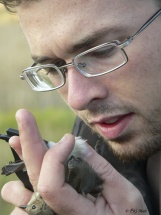Habitat choice: evolution and eco-evolutionary consequences

Staffan Jacob
Station d’Ecologie Expérimentale du CNRS USR CNRS 2936, Moulis, France - jacobstaffan@gmail.com
(Seminar in English)
Dispersal is among the main processes driving eco-evolutionary dynamics, affecting colonization-extinction dynamics in metapopulations, species range-distribution and local adaptation. Local adaptation especially is commonly assumed to require limited gene flow, because dispersal should homogenise gene pools. Conversely, when dispersal involves habitat choice, gene flow can involve a non-random subset of locally adapted genotypes that can speed-up rather than hinder local adaptation. However, our comprehension of the drivers of habitat choice evolution and its ensuing eco-evolutionary consequences remains weak.
I will present results from microcosm experiments of the actively dispersing ciliate Tetrahymena thermophila. We provide the first experimental evidence that local adaptation is favoured by dispersal with adaptive habitat choice, while hindered under random dispersal. We furthermore found that while habitat choice is associated with thermal specialism, as predicted by theory, generalists showed a preference for marginal habitats. Using mathematical simulations, we found that this dispersal strategy should favour the coexistence between generalists and specialists.
Recent publications:
Jacob et al. (2016) Cooperation-mediated plasticity in dispersal and colonization. Evolution. 70, 2336-2345.
Jacob et al. (2015) Habitat matching and spatial heterogeneity of phenotypes: implications for metapopulation and metacommunity functioning. Evolutionary Ecology. 29, 851-871.
Jacob et al. (2015) Social information from immigrants: multiple immigrant-based sources of information for dispersal decisions in a ciliate. Journal of Animal Ecology. 84, 1373-1383
Ophélie Ronce ophelie.ronce@univ-montp2.fr
Contact du Comité SEEM: seem@services.cnrs.fr. Contact du Labex CEMEB: gestion.cemeb@univ-montp2.fr


